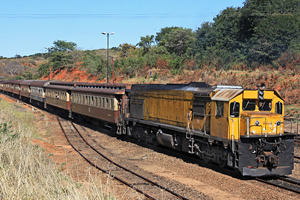
National Railways of Zimbabwe’s revenue for eight months to August 2013 dropped 11 percent to US$54,74 million
Happiness Zengeni Business Editor—
THE National Railways of Zimbabwe’s revenue in the eight months to August 2013 dropped by 11 percent to US$54,74 million from US$61,96 million in the comparable period the prior year as the state-owned institution continued to lose business due to poor and unserviced infrastructure.
According to latest statistics from Zimbabwe National Statistical Agency, the company’s revenue at half year was US$36,1 million averaging around US$6 million per month. However, there was significant growth from July and August which pushed the average revenue to about US$7 million per month.
Minerals and ores remained the major driver of revenue at US$22,81 million, a decrease of 14,81 percent from US$26,775 million in 2012. Coal was the major driver accounting for more than half of the revenue. Agricultural produce was at US$8,22 million while coaching or passenger services were below US$3 million in the period.
However, in spite of the US$7 million monthly revenue, expenditures are around US$10,5 million. In 2012, total revenue amounted to US$92,62 million a 17 percent drop from US$112,66 million.
NRZ requires about US$260 million in the short to medium term and is currently negotiating with possible financiers that will help it implement its recapitalisation programme.
The programme is aimed at rehabilitating the track, signalling and communication equipment and refurbishment of locomotives and wagons. Resources allocated by treasury have been channelled to this same cause.
The network has 14 percent caution infestation, which is the equivalent of potholes on the road surface. These cautions are spread all over the track. The track covers 2 760 kilometres and was designed to carry 18 million tonnes of traffic every year in 1897. The effect of these cautions on the tracks is that it becomes difficult to navigate since there are single lanes. Drivers have to travel slowly until they get past the caution area. Journeys therefore take longer.
Secondly there are no signals and telecommunication systems as they were either vandalised or are now obsolete. In such situations, the likelihood for collisions is high. Use is made of human intervention and the Global Positioning System, which is SMS-based. Unfortunately the GPS is also not as reliable.
Thirdly, is the commonly quoted problem of the old locomotives, which are past their lifespan (expired in 1960) and because of sanctions they have not been repaired. The heads are from General Motors while others are from General Electric, all American companies. The use of middlemen to get spare parts is therefore very expensive.
NRZ also has a programme under the Public-Private Partnership arrangement, where customers are allowed to provide capital for the procurement of spares for wagons and locomotives in return for dedicated service.
Analysts have suggested different restructuring processes for NRZ. Some of the suggestions include vertical separation, where ownership and maintenance of infrastructure would be removed from running of the system. Under the arrangement new players would be brought in and NRZ would operate toll gates.
The current NRZ would remain running freight and passenger services only after which it and other railway operators would have to pay access fees to use the system. There would be need for a regulator once space is opened up.
Several other options such as privatisation and concessions could also be considered.
However, privatisation would not be a viable option as railway infrastructure and its operations are capital-intensive while the return on investment is long term in nature.
Concessions also proved to be unsuccessful in other countries. Railway concessions are contracts that are entered into between governments for an investor to operate in a particular area of the railway system.
As part of its recapitalisation efforts four years ago NRZ paid a 10 percent deposit to a Chinese company for the purchase of 14 locomotives worth US$29 million. However, the deal could not be concluded as Government failed to guarantee it.